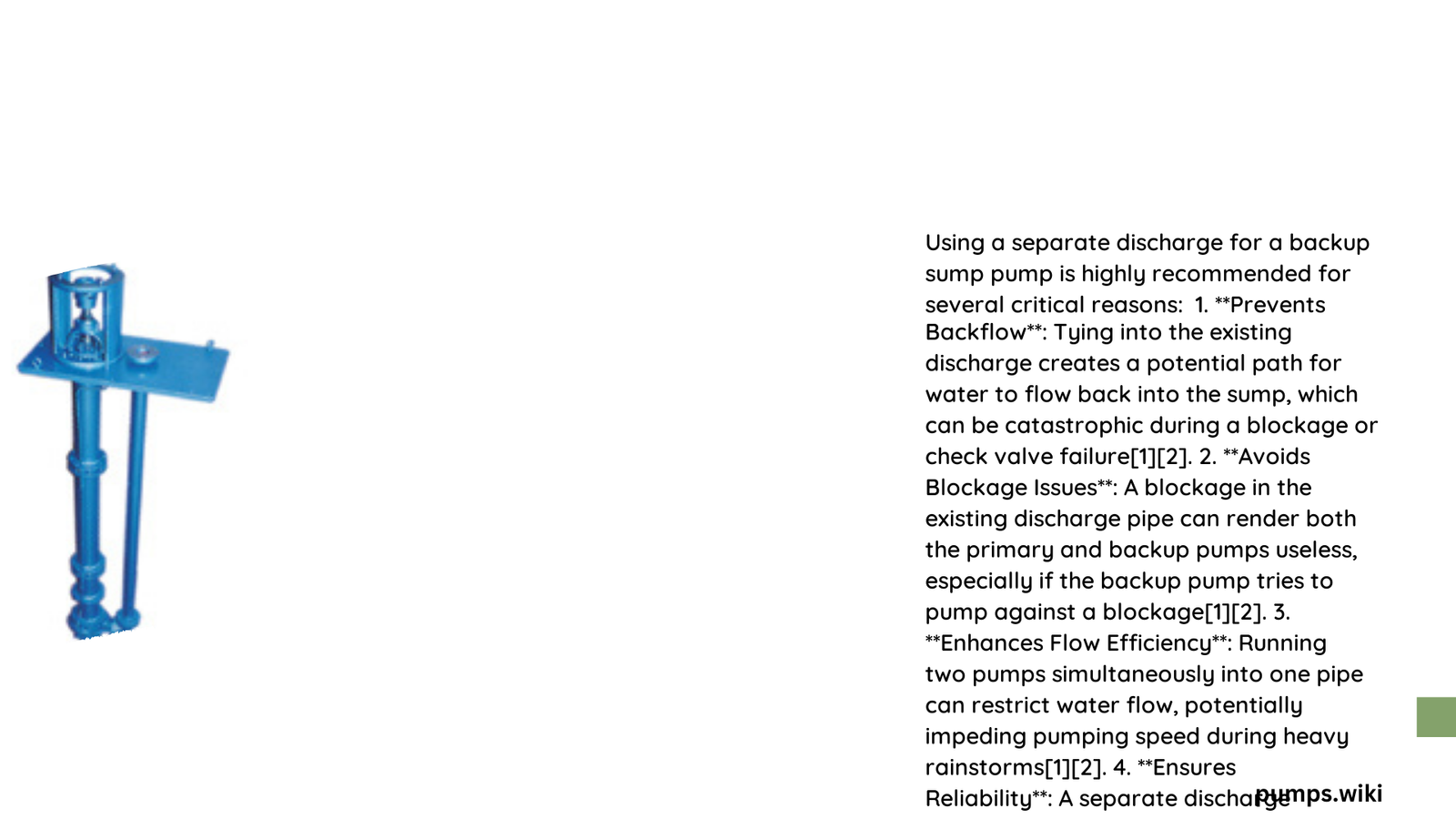A backup sump pump separate discharge is a critical component of a comprehensive flood protection system for homes. This setup involves installing a secondary sump pump with its own dedicated discharge pipe, independent from the primary pump’s discharge line. This configuration ensures continued water removal during power outages or primary pump failures, significantly enhancing a home’s defense against flooding and water damage.
What Are the Key Benefits of a Backup Sump Pump Separate Discharge?
The primary advantages of implementing a backup sump pump with a separate discharge include:
- Increased reliability during emergencies
- Reduced risk of system failure due to clogged pipes
- Enhanced water removal capacity
- Improved overall flood protection for your home
How Does a Backup Sump Pump Separate Discharge System Work?

A backup sump pump separate discharge system operates as follows:
- The backup pump is installed alongside the primary pump in the sump pit.
- It has its own dedicated discharge pipe that runs independently to the exterior of the house.
- When the primary pump fails or can’t keep up with water inflow, the backup pump activates.
- Water is pumped out through the separate discharge pipe, ensuring continued protection even if the main discharge line is compromised.
What Are the Installation Requirements for a Backup Sump Pump Separate Discharge?
Installing a backup sump pump with a separate discharge requires careful planning and execution. Here are the key requirements:
Materials Needed:
- Backup sump pump (battery-powered or water-powered)
- 1½-inch diameter PVC pipe
- PVC cement and primer
- Check valve (rated for at least 75 PSI)
- Pipe clamps
- Extension cable (if needed)
Installation Steps:
- Choose an appropriate location for the backup pump in the sump pit.
- Install the pump according to manufacturer instructions.
- Measure and cut the PVC pipe for the new discharge line.
- Install a check valve on the discharge pipe near the pump.
- Route the discharge pipe to the exterior of the house, ensuring proper slope.
- Secure the pipe with clamps and seal all joints with PVC cement.
- Test the system to ensure proper operation.
How Does the Efficiency of a Backup Sump Pump with Separate Discharge Compare to Standard Setups?
A backup sump pump with separate discharge offers several efficiency advantages:
| Feature | Separate Discharge | Shared Discharge |
|---|---|---|
| Flow Rate | Unimpeded | Potentially restricted |
| Risk of Failure | Lower | Higher |
| Maintenance | Easier | More complex |
| Overall Reliability | Higher | Lower |
Separate discharge systems typically allow for:
– Higher flow rates (up to 2,000 gallons per hour for some models)
– Continuous operation without interference from the primary system
– Easier troubleshooting and maintenance
What Are the Critical Considerations for Sump Pump Discharge Location?
When determining the discharge location for your backup sump pump, consider the following:
-
Minimum Distance from Property Lines: Maintain at least 3-5 feet distance from property boundaries to prevent water flow onto neighboring properties.
-
Elevation Requirements: Ensure a proper slope (typically 1/4 inch per foot) to facilitate water flow away from the house.
-
Environmental Impact:
- Avoid discharging into storm drains or retention ponds
- Prevent erosion by directing water to appropriate drainage areas
-
Consider local regulations regarding water discharge
-
Freeze Prevention: In cold climates, ensure the discharge point is protected from freezing to maintain year-round functionality.
What Are the Estimated Costs and Timeframes for Installing a Backup Sump Pump Separate Discharge?
The costs and timeframes for installation can vary based on several factors:
Estimated Costs:
- Backup Sump Pump: $200 – $1,000
- Materials (pipe, fittings, etc.): $100 – $300
- Professional Installation: $500 – $1,500
Total Cost Range: $800 – $2,800
Timeframe for Installation:
- DIY Installation: 1-2 days (depending on experience)
- Professional Installation: 4-8 hours
Factors affecting installation time include:
– Complexity of the existing plumbing system
– Ease of access to exterior walls for pipe routing
– Type of backup pump being installed (battery vs. water-powered)
How Can Homeowners Maintain Their Backup Sump Pump Separate Discharge System?
To ensure the longevity and effectiveness of your backup sump pump separate discharge system, follow these maintenance tips:
- Test the backup pump quarterly by lifting the float switch
- Inspect and clean the check valve annually
- For battery-powered systems, check and replace the battery as needed (typically every 2-3 years)
- Clear the discharge pipe exit point of debris or obstructions regularly
- Schedule annual professional inspections to catch potential issues early
By following these guidelines, homeowners can maximize the protection offered by their backup sump pump separate discharge system, ensuring peace of mind during heavy rains and potential flooding events.
References:
1. https://www.waterdamagedefense.com/pages/basepump-water-powered-sump-pump-discharge-options
2. https://www.watercommander.com/articles/why-independent-discharge-for-your-backup-sump-pump-is-best
3. https://www.mrrooter.ca/about/blog/2020/september/how-to-install-a-backup-sump-pump/
